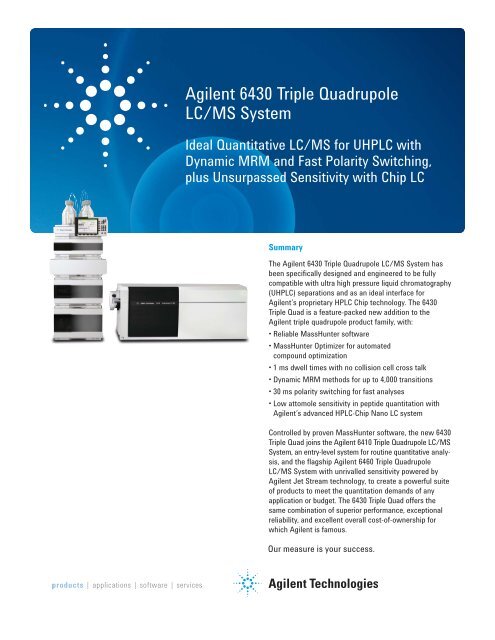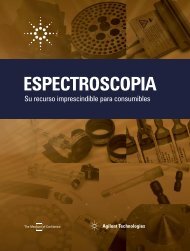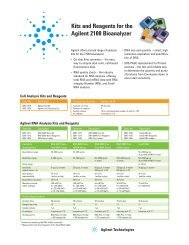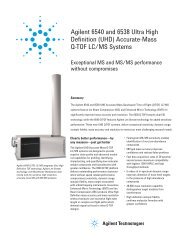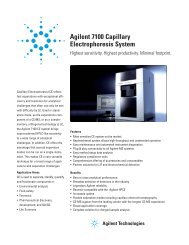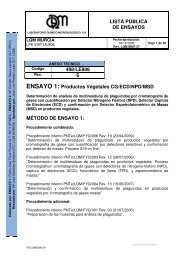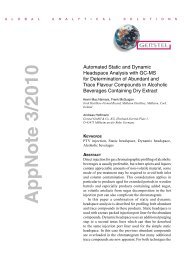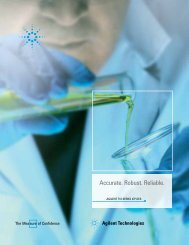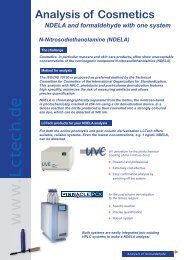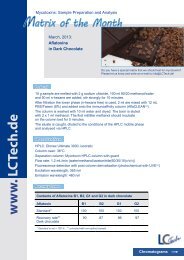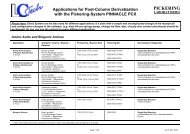Agilent 6430 Triple Quadrupole LC/MS System - Perlan Technologies
Agilent 6430 Triple Quadrupole LC/MS System - Perlan Technologies
Agilent 6430 Triple Quadrupole LC/MS System - Perlan Technologies
- No tags were found...
Create successful ePaper yourself
Turn your PDF publications into a flip-book with our unique Google optimized e-Paper software.
<strong>Agilent</strong> <strong>6430</strong> <strong>Triple</strong> <strong>Quadrupole</strong><strong>LC</strong>/<strong>MS</strong> <strong>System</strong>Ideal Quantitative <strong>LC</strong>/<strong>MS</strong> for UHP<strong>LC</strong> withDynamic MRM and Fast Polarity Switching,plus Unsurpassed Sensitivity with Chip <strong>LC</strong>SummaryThe <strong>Agilent</strong> <strong>6430</strong> <strong>Triple</strong> <strong>Quadrupole</strong> <strong>LC</strong>/<strong>MS</strong> <strong>System</strong> hasbeen specifically designed and engineered to be fullycompatible with ultra high pressure liquid chromatography(UHP<strong>LC</strong>) separations and as an ideal interface for<strong>Agilent</strong>’s proprietary HP<strong>LC</strong> Chip technology. The <strong>6430</strong><strong>Triple</strong> Quad is a feature-packed new addition to the<strong>Agilent</strong> triple quadrupole product family, with:• Reliable MassHunter software• MassHunter Optimizer for automatedcompound optimization• 1 ms dwell times with no collision cell cross talk• Dynamic MRM methods for up to 4,000 transitions• 30 ms polarity switching for fast analyses• Low attomole sensitivity in peptide quantitation with<strong>Agilent</strong>’s advanced HP<strong>LC</strong>-Chip Nano <strong>LC</strong> systemControlled by proven MassHunter software, the new <strong>6430</strong><strong>Triple</strong> Quad joins the <strong>Agilent</strong> 6410 <strong>Triple</strong> <strong>Quadrupole</strong> <strong>LC</strong>/<strong>MS</strong><strong>System</strong>, an entry-level system for routine quantitative analysis,and the flagship <strong>Agilent</strong> 6460 <strong>Triple</strong> <strong>Quadrupole</strong><strong>LC</strong>/<strong>MS</strong> <strong>System</strong> with unrivalled sensitivity powered by<strong>Agilent</strong> Jet Stream technology, to create a powerful suiteof products to meet the quantitation demands of anyapplication or budget. The <strong>6430</strong> <strong>Triple</strong> Quad offers thesame combination of superior performance, exceptionalreliability, and excellent overall cost-of-ownership forwhich <strong>Agilent</strong> is famous.
Fast MRM Analysis and PolaritySwitching (Plus Sensitivity) —Perfect for UHP<strong>LC</strong>The 1290 Infinity <strong>LC</strong> <strong>System</strong> for UHP<strong>LC</strong>offers tremendous productivity gainsversus conventional HP<strong>LC</strong>. UHP<strong>LC</strong> withsub-2-micron columns can dramaticallyreduce separation times and maximizechromatographic resolution. This frequentlyresults in very narrow peakswhich may be less than a second wide.The new <strong>6430</strong> <strong>Triple</strong> Quad has beenengineered to achieve optimal quantitationof narrow UHP<strong>LC</strong> peaks.Reliable peak integration requires atleast ten data points across a peak,mandating <strong>MS</strong> cycle times as low as100 ms for a second-wide peak. Complex,multi-analyte assays require very shortdwell times. The <strong>6430</strong> <strong>Triple</strong> Quad cankeep up! It features extremely fast ionmonitoring and polarity switching. Theenhanced electronics in the <strong>6430</strong> <strong>Triple</strong>Quad enable 1 ms dwell times with nocollision cell cross talk. Further, theintroduction of dynamic MRM methodsallows dynamic selection of MRM transitionsduring a method, based onretention time windows, to optimizeinstrument cycle time and maximize collectionof high quality quantitative data. 1This allows hundreds of compounds tobe analyzed in a single <strong>LC</strong>/<strong>MS</strong> run.Samples containing compounds withboth positive and negative ion transitionsrequire fast polarity switching – the<strong>6430</strong> <strong>Triple</strong> Quad can change polarityand begin acquiring data in just 30 ms.The improvement in polarity switchingtimes is derived from a new, resistivelycoated capillary that reacts very quicklyto voltage changes.In addition to fast analysis capabilities,the <strong>6430</strong> <strong>Triple</strong> Quad is more sensitivethan its predecessor – it has a standardsecond turbo pump in the Q3 region toenhance ion transmission by reducingchemical noise.Designed as an IDEAL SYSTEM for UHP<strong>LC</strong>/<strong>MS</strong> Analyses• 1200 bar pressure (up to 2 mL/min) for the fastest separations• 30 ms polarity switching for fast peaks• 1 ms dwell times for analyzing hundreds of compounds• Dynamic MRM methods for analyzing thousands of ion transitions• Improved sensitivityFigure 1: The <strong>Agilent</strong> 1290 Infinity <strong>LC</strong> <strong>System</strong> and the <strong>Agilent</strong> <strong>6430</strong> <strong>Triple</strong><strong>Quadrupole</strong> <strong>LC</strong>/<strong>MS</strong> <strong>System</strong>. The <strong>6430</strong> <strong>Triple</strong> Quad is an ideal <strong>MS</strong> system forUHP<strong>LC</strong> separations.2
As part of a metabolic stability assay 2(Figure 2), several pharmaceuticalcompounds and their metabolites wereseparated using a 1.5 min method withthe <strong>Agilent</strong> 1290 Infinity <strong>LC</strong> <strong>System</strong>,using a sub-2-micron column and pressureof 1060 bar. The diclofenac iontransition was monitored along withfour other positive ion transitions andone negative ion transition. The cycletime for six ion transitions and positive/negativepolarity switching was lessthan 115 ms. This narrow peak wassampled 9 times, creating an excellentbasis for peak area determination - thearea RSD value for diclofenac was lessthan 5%.x10 33.83.432.62.21.81.410.6-MRM (294.0 -> 250.0)Diclofenac, narrowest peakAverage W 1/2= 0.37 sec9 points across WRel. Area RSD [%] = 7.9Area RSD [%] = 4.8Dynamic MRM Methods EnableComplex Multi-Residue AnalysesDynamic MRM methods dramaticallyreduce <strong>MS</strong> cycle times for complexmulti-analyte assays. MRM transitionlists are built dynamically during the<strong>LC</strong> separation based on a retention timewindow for each analyte. Using thedynamic MRM method capabilities ofthe <strong>6430</strong> <strong>Triple</strong> Quad, 224 pesticideswere analyzed in only 7 min as shownin Figure 3. The average peak widthswere about 1 sec wide, requiring an<strong>MS</strong> cycle time of about 100 ms forprecise and accurate quantitation of allcompounds. The minimum dwell timewas a very fast 2.5 ms. The excellentretention time precision of the 1290Infinity <strong>LC</strong> allowed very narrow retentiontime windows and reduced thenumber of required ion transitions atany point during the chromatogram tofewer than 20. The precision of thisvery fast pesticide assay was excellent,with an average peak area RSD of lessthan 5%.0.20.7 0.71 0.72 0.73 0.74 0.75 0.76 0.77Counts vs. Acquisition Time (min)W = 1.5 secCycle time = 114 msFig. 2: MRM chromatogram of diclofenac obtained using a flow rate of 1.5 mL/min. The graphicshows the peak width at half height (0.37 sec) and the number of data points collected acrossthe peak (9 data points).Figure 3. Fast analysis of 224-pesticides at the 500 ppt level in less than 7 min using the new<strong>Agilent</strong> 1290 Infinity <strong>LC</strong> and <strong>6430</strong> <strong>Triple</strong> Quad with dynamic MRM. Average peak area RSD was lessthan 5%.3
Robust, Reliable, SensitiveNanospray with HP<strong>LC</strong>-ChipThe highest possible sensitivity in<strong>LC</strong>/<strong>MS</strong> is achieved with the smallestcolumn diameters. Nano <strong>LC</strong> columnswith an i.d. of 75 microns offer anobvious route to high sensitivity buthave historically suffered from a lack ofrobustness and precision. <strong>Agilent</strong>’s revolutionaryHP<strong>LC</strong>-Chip/<strong>MS</strong> technologyprovides nanoscale <strong>LC</strong> on a plug-and-playmicrofluidic chip, minimizing leaks anddead volumes. The chip contains a fullyintegrated electrospray emitter forunprecedented spray stability.Figure 4. ChipCube with integrated valves, columns and spray tip.The <strong>6430</strong> <strong>Triple</strong> Quad with an HP<strong>LC</strong>-Chip/<strong>MS</strong> interface is ideal for targetedprotein quantitation using dynamicMRM methods. This system canachieve low attomolar sensitivity (seeFigure 5) in plasma protein digests.Figure 5. Attomolar detections limits for exogenous peroxidase protein spiked into immunodepletedhuman plasma, analyzed with the HP<strong>LC</strong>-Chip coupled with a <strong>6430</strong> <strong>Triple</strong> Quad.4
Dynamic MRM methods on the HP<strong>LC</strong>-Chip/<strong>6430</strong> <strong>Triple</strong> Quad system can beused to quantitate hundreds or thousandsof peptides, as shown in theanalysis of the complex peptide digestshown in Figure 6. More than 2,000 iontransitions were monitored during this<strong>LC</strong>/<strong>MS</strong> analysis.ConclusionsThe new <strong>Agilent</strong> <strong>6430</strong> <strong>Triple</strong> Quad<strong>LC</strong>/<strong>MS</strong> features seamless integrationwith the <strong>Agilent</strong> 1290 Infinity <strong>LC</strong><strong>System</strong> and the proprietary <strong>Agilent</strong>HP<strong>LC</strong>-Chip/<strong>MS</strong> nanospray interface.This new system features:• Extensive sampling capabilities fornarrow UHP<strong>LC</strong> peaks• Fast 1 ms MRM dwell times• Dynamic MRM methods for complex,multi-analyte assays• Fast 30 ms polarity switching times• Attomole sensitivity for biomarkervalidation studies using theHP<strong>LC</strong>-Chip and <strong>6430</strong> <strong>Triple</strong> Quad• Rugged, reliable MassHuntersoftware control• Automated method optimization usingMassHunter Optimizer and PeptideOptimizer software• 21 CFR Part 11 support forvalidated methodsWith legendary <strong>Agilent</strong> robustness andreliability, and a commitment to highestquality service and support, the <strong>6430</strong><strong>Triple</strong> Quad is a productive new additionto the <strong>Agilent</strong> 6400 Series <strong>Triple</strong><strong>Quadrupole</strong> <strong>LC</strong>/<strong>MS</strong> product family.Figure 6. 2,000 Dynamic MRM transitions from the tryptic digest of immunodepleted human plasmausing the HP<strong>LC</strong>-Chip/<strong>6430</strong> <strong>Triple</strong> Quad system.References1. Peter Stone, Thomas Glauner, FrankKuhlmann, Tim Schlabach and KenMiller, “New Dynamic MRM ModeImproves Data Quality and <strong>Triple</strong>Quad Quantification in ComplexAnalyses,” <strong>Agilent</strong> publicationnumber 5990-3595EN, 2009.2. Anabel S. Fandiño, Edgar Naegele,“Metabolic Stability Study UsingCassette Analysis and PolaritySwitching in a UHP<strong>LC</strong> <strong>Triple</strong> Quad<strong>LC</strong>/<strong>MS</strong> <strong>System</strong>,” <strong>Agilent</strong> publicationnumber 5990-4469EN, 2009.5
www.agilent.com/chem/qqqThis item is intended for Research Use Only. Not for usein diagnostic procedures. Information, descriptions, andspecifications in this publication are subject to changewithout notice.<strong>Agilent</strong> <strong>Technologies</strong> shall not be liable for errors containedherein or for incidental or consequential damagesin connection with the furnishing, performance or use ofthis material.© <strong>Agilent</strong> <strong>Technologies</strong>, Inc. 2009Printed in the U.S.A. December 22, 20095990-4788EN


